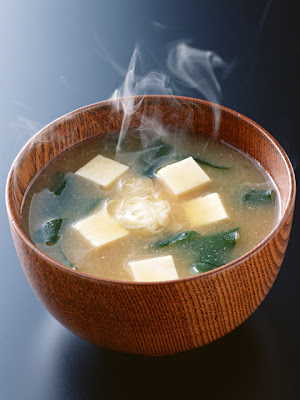Seasonal Food In Mid February

I guess I didn't explain very well in the last post about the future of food, what do I mean by seasonal vegetables or foods in season (shun). Especially in winter, and mid February, you may ask, "What did people eat in Japan in the past?"
Well, if they had saved some rice or barley, that would be great, as well as some tubers (possibly, but not in the more ancient past).



As for vegetables, most people probably survived on radish (daikon) and early greens such as mizuna and nanohana (rape or canola of the brassica family). Other leaf veggies that do well around this time include chingen, but I'm not sure how common that may have been. Most likely, farmers had plenty of kabocha (winter squash) and hakusai (napa cabbage) that farmers keep in the field all winter, and harvest little by little. Gobo (a root) and negi (leech, a kind of spring onion) are also wonderful.

All this goes well in a nabe, boiled as a soup or stew, preferably with miso (fermented soy paste). Tori nabe would include chicken, but I don't think that was common. If you have saved soybeans, you could also make tofu and get your proteins. Anything else you need? Mushrooms, perhaps, especially shiitake. You could add eggs, and if you lived near a stream or a lake, probably some fish, from a satoyama region with creaks or streams from the hills and mountains. Meat - optional.
 Kuri (chestnuts) were very important in winter, roasted or boiled. Some fruit, most likely yuzu, for vitamin C. Hopefully some sake, at least for a special occasion...
Kuri (chestnuts) were very important in winter, roasted or boiled. Some fruit, most likely yuzu, for vitamin C. Hopefully some sake, at least for a special occasion...
Photos collected from around the web:
Tori nabe (Check out the post about Kenchinjiru, a warm vegan soup from Kamakura!)
Miso soup
Kuri chestnuts
Daikon radishes
Colourful daikon radishes
Chingen
Nanohana
She who eats is a blog with food related posts, but unfortunately, Chika has a strict copyright rule so I cannot show any of her photos of her winter vegetables, roots and leaves. Do take a look anyway, her winter comforts in the pot is terrific!
When reading about ancient Japanese history, I'm often surprised how ignorant the authors and historians are about how ordinary people lived. We know a lot about the noble people, say in Heian era Kyoto, but very little about the farmers and others. Not only that, but it seems the experts do not care. It is so much more fun to write about the splendid, dashing Emperors and poetry-writing Princes, rather than mention much about the rest of the population.



Comments
I think kabocha is called pumpkin or squash in English :)
Your Japanese is much better than mine--but isn't kabocha the delicious squash with green skin. I eat it all the time. I may be wrong though.
There's a great Japanese historian - Yoshihiko Amino -- who wrote about ordinary people in Japanese hitory. But not much translated into English. I have a link somewhere to one of the few online articles--I'll share when I find it.
I loved this post. Japanese really know how to approach food, cuisine and enjoy this wonderful aspect of life--like the French.
JD